Home / Pyranoses and Furanoses: Ring-Chain Tautomerism In Sugars
Carbohydrates
Pyranoses and Furanoses: Ring-Chain Tautomerism In Sugars
Last updated: July 4th, 2025 |
Pyranoses , Furanoses, Straight-Chain Glucose, And Ring-Chain Tautomerism
- Sugars such as glucose exist in equilibrium between their open-chain form and various cyclic forms where an OH group and an aldehyde combine to form a cyclic hemiacetal.
- In the case of glucose, a 5- or 6- membered ring can form, depending on which hydroxyl group adds to the aldehyde. Equilibrium tends to favor the six-membered cyclic form, called “pyranose” since it resembles pyran, although some of the five-membered cyclic form (“furanose“) is also present along with the open-chain form.
- In the process of forming the hemiacetal a new chiral center is created. This gives rise to two diastereomers which for historical reasons are called anomers and designated “alpha” or “beta” depending on the orientation of the -OH group.

Table of Contents
- Glucose Comes In Many Forms
- Hydrates, Hemiacetals, and Cyclic Hemiacetals
- Ring-chain Tautomerism In Glucose: The “Pyranose” Form
- Ring-Chain Tautomerism In Glocose, II: The “Furanose” Form
- Glucose Has Several Structures, All In Equlibrium With Each Other?
- Conclusion: Pyranose vs Furanose vs Open-Chain Forms of Glucose
- Notes
- Quiz Yourself!
- (Advanced) References and Further Reading
1. Glucose Comes In Many Forms
What’s the structure of glucose?
A simple question! but one with many “right” answers.
The first question to ask, which we covered in our recent post on D- and L- sugars, is: “Which enantiomer are you talking about?”. If, by “glucose”, you mean the enantiomer we commonly encounter as blood sugar, then you’re referring to D-glucose. In its open chain form, when drawn as a Fischer projection, D-glucose looks like this:

The fact that I had to specify “open-chain form” might tip you off that something is amiss. That’s because glucose, like a snake that bites its own tail, or a belt – can adopt a cyclic form as well. And not just one cyclic form, but several!
Before diving into these, it’s worth a quick refresher on the two main functional groups in glucose (and other sugars) which make this possible: hydroxyl groups and aldehydes (or ketones, in the case of keto-sugars like fructose).
2. Hydrates, Hemiacetals, and Cyclic Hemiacetals
You may recall that aldehydes (and ketones, but we’ll focus on aldehydes here) can reversibly react with water to form “hydrates“. (relevant article: Acetals, Hemiacetals, Hydrates). Hydrates form readily in solution, but they tend not to be easy to isolate; the equilibrium tends to favor the starting aldehyde. [Note 1].

Refresher on mechanism – hover here to bring up a picture of the mechanism or click this link.
Similarly, aldehydes can react with alcohols to form hemiacetals. Like hydrate formation, hemiacetal formation is an equilibrium and the equilibrium tends to favor the starting aldehyde. [If you heat with acid, excess alcohol and sequester the water that forms, it forms an acetal ; this is not in equilibrium with the hemiacetal, which is why acetals are a great protecting group for aldehydes/ketones].

If you need a refresher on the mechanism, hover here or click this link.
Here’s the twist – and the relevance to glucose. If the alcohol and the aldehyde are part of the same molecule, then it’s possible for the hemiacetal formation to be intramolecular, forming a cyclic hemiacetal in the process. The mechanism is exactly the same as in the previous case. Note the difference is that I’ve just drawn ONE extra bond (in blue)
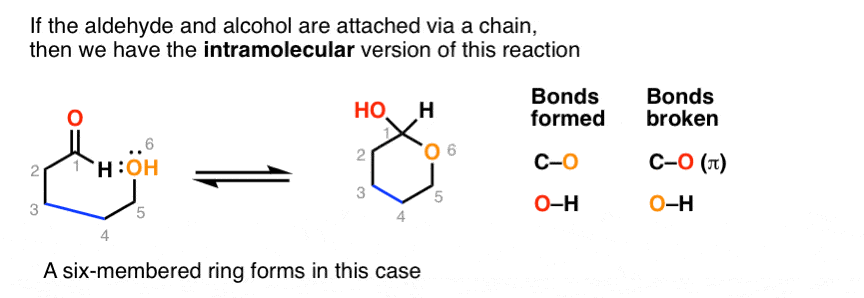
In the case above (5-hydroxy pentanal), we form a six-membered ring.
Here’s how it works, step by step:

So, you might ask: what’s the “correct” structure of this molecule – the “linear” or the “cyclic” form?
The answer is that since these two forms are in equilibrium, they are both “correct” structures of this molecule, even though they are structural isomers of each other.
You might recall seeing a similar type of situation with certain ketones and aldehydes, where a ketone is in equilibrium between a “keto-” form and an “enol” form which are themselves structural isomers of each other. We called that keto-enol tautomerism. hover here to see an example or click on this link
The equilibrium between the linear and cyclic form of 5-hydroxy pentanal (above) is a different type of tautomerism we call ring-chain tautomerism.
3. Ring-Chain Tautomerism In Glucose: The “Pyranose” Form
This is exactly what happens in glucose. The alcohol on C-5 of glucose can react with the aldehyde (C-1) to form a six-membered ring (I skipped drawing in the proton transfer in the drawing below).

The linear and cyclic forms are structural isomers that exist in equilibrium with each other, so this is another example of ring-chain tautomerism.
The 6-membered cyclic form of sugars is usually called the “pyranose” form in reference to the cyclic ether pyran.
If you’re eagle-eyed, you might have noticed that in the process of forming a new C-O bond, a new chiral centre is formed at C-1. This new chiral centre can have one of two configurations, (S) or (R). Since there are other chiral centers on glucose and their R/S configurations don’t change, that means we’ll end up with a pair of diastereomers: stereoisomers that are not enantiomers. Rather than using the (R) and (S) descriptors, the convention with sugars is to name them according to the orientation of the OH groups on C-1 relative to the C-5 group. These two isomers are referred to as the alpha (α) and beta (β) isomers [Note 2] for more detail on this]
- In the alpha (α) isomer, the OH group on C-1 is on the opposite face of the ring from the CH2OH substituent on C-5. This can be seen from drawing the molecule as a chair, but it is often helpful to draw a hexagonal version of a sugar in perspective (called a “Haworth projection“) that makes the stereochemical relationships more clear.
- In the beta (β) isomer, the OH group on C-1 is on the same face of the ring relative to the CH2OH substituent on C-5.
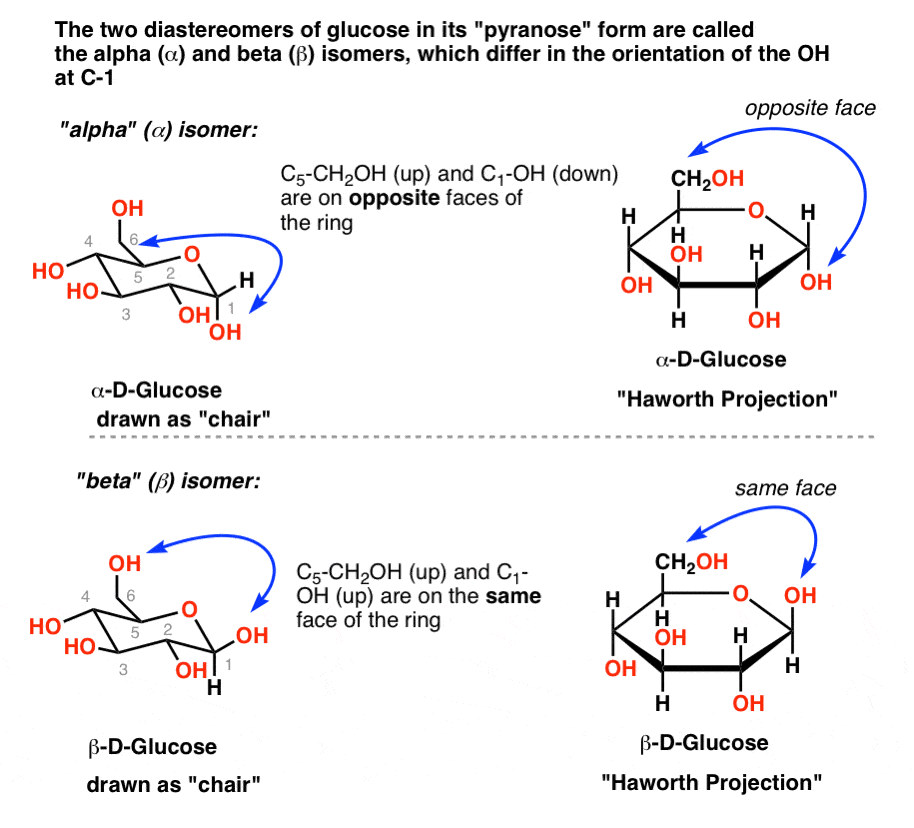
At the risk of inciting a pitchfork-wielding mob angry at the introduction of even more terminology, these two isomers are often referred to as “anomers“, but that is a topic for another day.
4. Ring-Chain Tautomerism In Glucose, II – The Furanose Form
But wait! that’s not all, folks!
The pyranose form of glucose is just one of the cyclic forms that glucose can adopt.
It’s also possible for the hydroxyl group on C-4 of glucose to attack the aldehyde. This forms a five-membered ring. We call this form the furanose form, in reference to the cyclic 5-membered ether furan. (Helpful mnemonic: Five = Furanose)
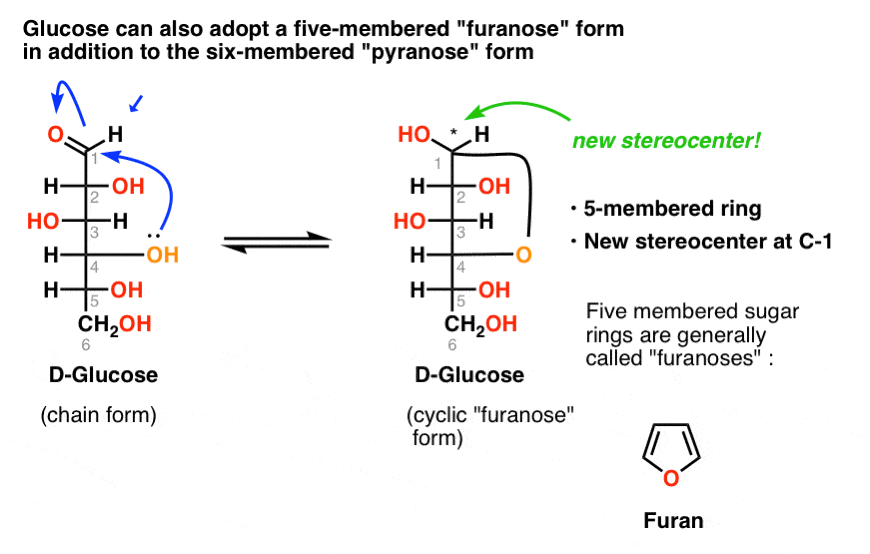
As with the pyranose, forming the 5-membered ring also generates a pair of diastereomers which differ in configuration at C-1. We likewise call these the alpha and beta forms, as above:

So what’s the structure of glucose? Not so straightforward, is it?
5. Glucose Has Several Structures, All In Equilibrium With Each Other
We’ve seen five separate isomers so far: the straight chain form, the pyranose form (alpha and beta), and the furanose form (alpha and beta).
In aqueous solution, these five forms are all in equilibrium with each other!
When you dissolve glucose in water, here’s the distribution you get:
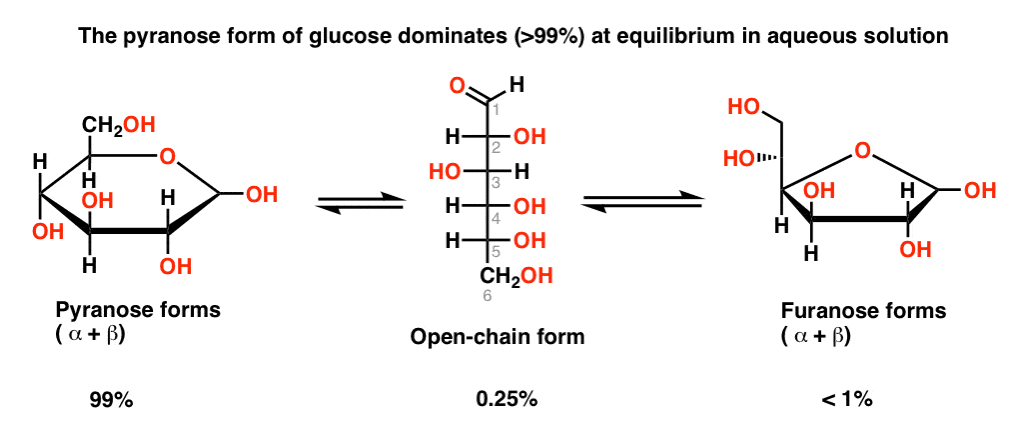
The pyranose forms dominate, with a small amount of the open-chain and furanose forms comprising the rest of the mixture.
What about 3 and 4 (or 7) membered rings, you might ask? [ Note 3. tl;dr they are insignificant]
6. Conclusion: Pyranose vs Furanose vs Open-Chain Forms Of Glucose
Although we’ve mainly discussed glucose in this post because it is the most familiar sugar, ring-chain tautomerism is an important property of all 5- and 6- carbon sugars.
Another familiar example is ribose, which comprises the sugar backbone of RNA:

Fructose is another one.
For Next Time: A Puzzle
Understanding this property of sugars will help us untangle a mystery which baffled early carbohydrate chemists.
- Pure α-D-glucose has a specific rotation of + 112°.
- Pure β-D-glucose has a specific rotation of + 19°.
- Yet when either of these two is dissolved in water, the optical rotation slowly changes to a value of + 52.5° .
Can you guess why?
We’ll talk about that in the next post in this series, on mutarotation (literally, “change in rotation”).
Many thanks to Tom Struble for assistance with this post.
Notes
Related Articles
Note 1. Aldehydes with adjacent electron-withdrawing groups tend to form more stable hydrates since the aldehyde carbon is much more electrophilic. Trichloroacetaldehyde (chloral hydrate) often known as “knockout drops”, is a prominent example.
Note 2. The α / β terminology pre-dates the R/S (Cahn-Ingold Prelog) terminology by several decades. The C-1 carbon is called the “anomeric” carbon and the α and β diastereoisomers are referred to as “anomers”. α and β are defined according to the relationship between the anomeric carbon and the anomeric reference carbon, which is the stereocenter farthest from the anomeric carbon in the ring. In D-glucose in the pyranose form the anomeric carbon is C-1 and the reference carbon is C-5. Here’s how IUPAC defines it.
Note 3. They’re not significant. Three and four-membered rings are relatively unstable due to their considerable ring strain, while the rate of seven-membered ring formation is extremely slow, relative to the 5- and 6- membered ring cases. ]
Note 4. From “Ring-Chain Tautomerism of Hydroxy Aldehydes”, Hurd C. D.; Saunders, W. H. J. Am. Chem. Soc. 1952 74, 5324.
DOI: 10.1021/ja01141a030
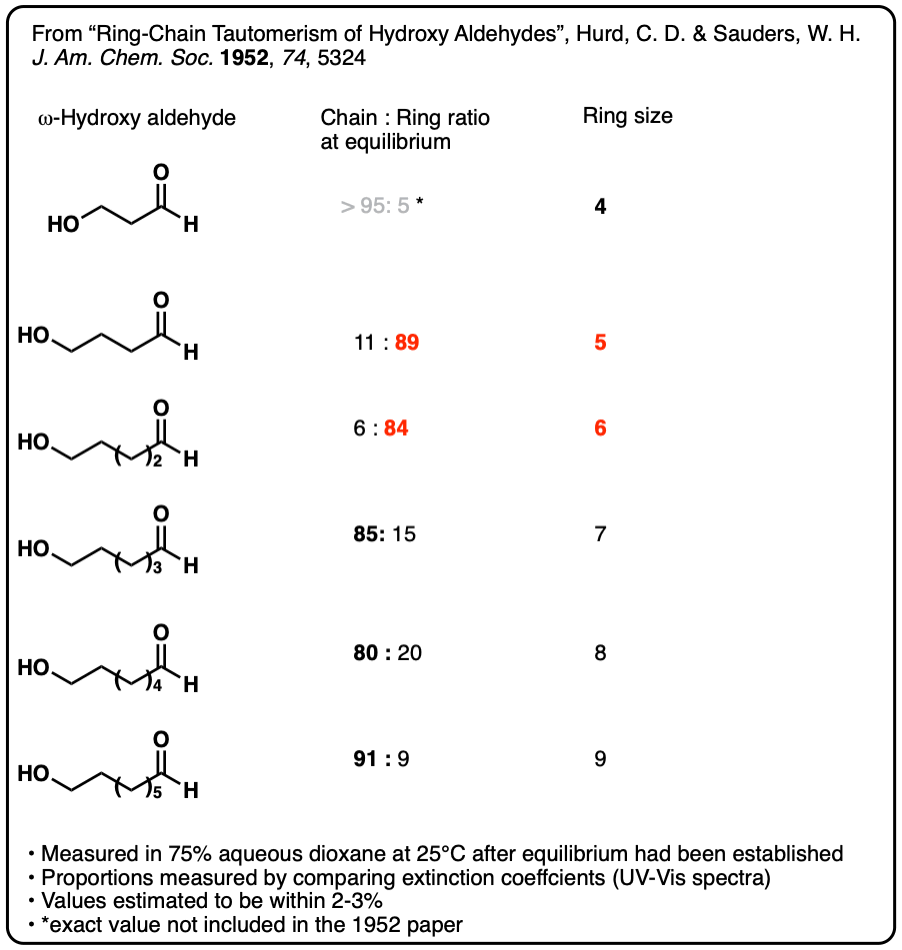
SUPER COOL. Reddit user Bean357 made this amazing stopmotion video of ring-chain tautomerism in glucose
(click takes you to video).
Quiz Yourself!
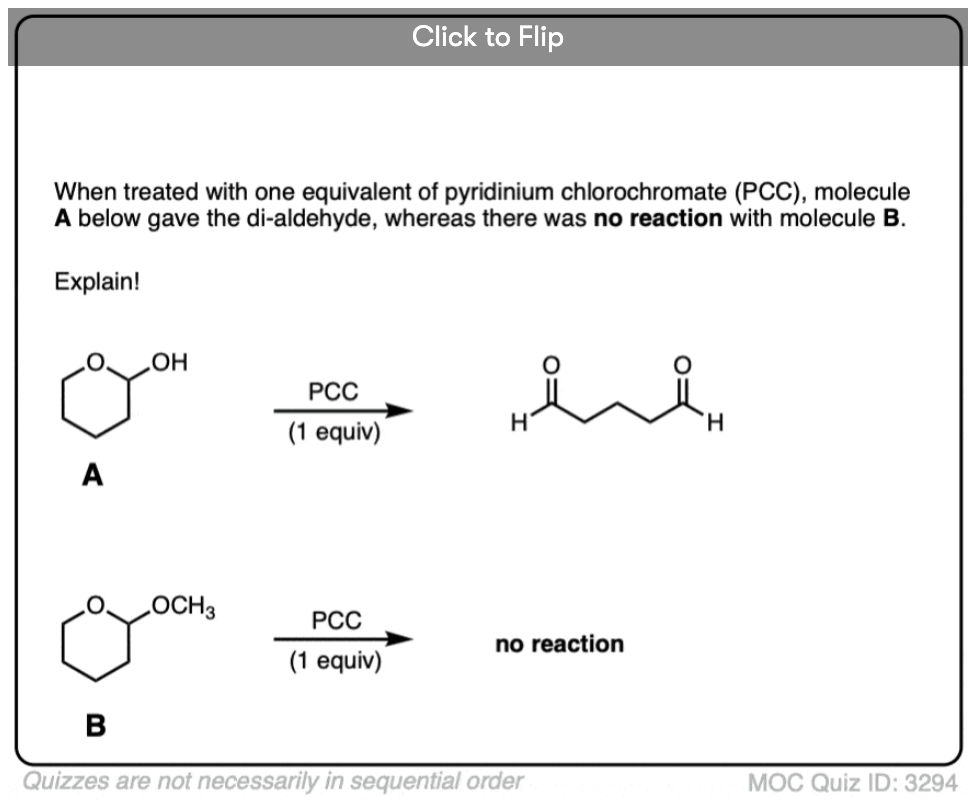
Become a MOC member to see the clickable quiz with answers on the back.

Become a MOC member to see the clickable quiz with answers on the back.

Become a MOC member to see the clickable quiz with answers on the back.

Become a MOC member to see the clickable quiz with answers on the back.
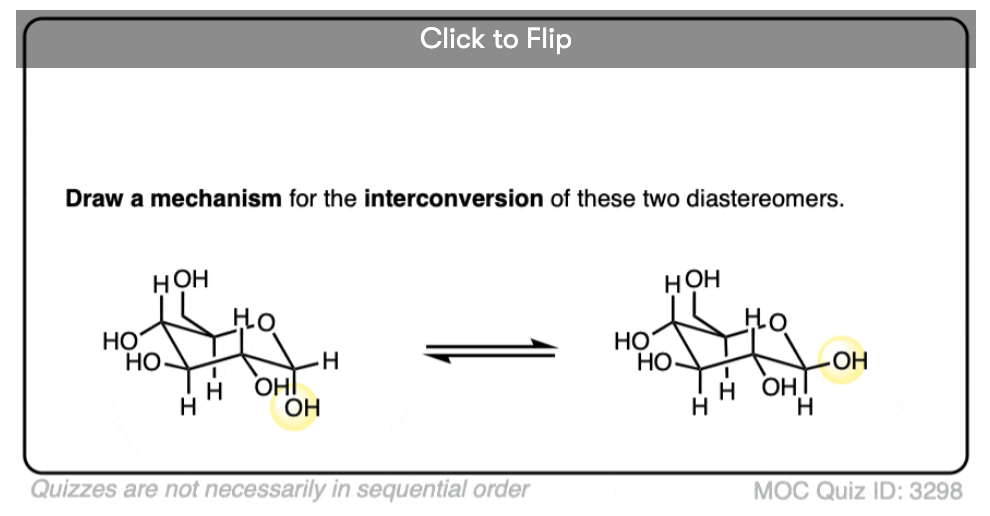
Become a MOC member to see the clickable quiz with answers on the back.

Become a MOC member to see the clickable quiz with answers on the back.
(Advanced) References and Further Reading
- Ring-Chain Tautomerism of Hydroxy Aldehydes
Hurd C. D.; Saunders, W. H.
J. Am. Chem. Soc. 1952 74, 5324.
DOI: 10.1021/ja01141a030
Source of the table in the notes. - Ring-Chain Tautomerism.
Paul R. Jones
Chemical Reviews 1963 63 (5), 461-487
DOI: 10.1021/cr60225a002
Classic review on the subject. - The ballet of nature: the interconvertible isomerisation of natural products
Ze-Jun Xu, Jing-Jing Han, Chun-Yang Zhang and Hong-Xiang Lou
Natural Product Reports 2025
DOI: d5np00019j
From the abstract: “This review comprehensively outlines the origins and chemical classifications of paired interconvertible isomers in nature, including positional, tautomeric, geometric, optical, and conformational isomerism. Particular focus is given to the formation mechanisms of these interconversion processes.”
00 General Chemistry Review
01 Bonding, Structure, and Resonance
- How Do We Know Methane (CH4) Is Tetrahedral?
- Hybrid Orbitals and Hybridization
- How To Determine Hybridization: A Shortcut
- Orbital Hybridization And Bond Strengths
- Sigma bonds come in six varieties: Pi bonds come in one
- A Key Skill: How to Calculate Formal Charge
- The Four Intermolecular Forces and How They Affect Boiling Points
- 3 Trends That Affect Boiling Points
- How To Use Electronegativity To Determine Electron Density (and why NOT to trust formal charge)
- Introduction to Resonance
- How To Use Curved Arrows To Interchange Resonance Forms
- Evaluating Resonance Forms (1) - The Rule of Least Charges
- How To Find The Best Resonance Structure By Applying Electronegativity
- Evaluating Resonance Structures With Negative Charges
- Evaluating Resonance Structures With Positive Charge
- Exploring Resonance: Pi-Donation
- Exploring Resonance: Pi-acceptors
- In Summary: Evaluating Resonance Structures
- Drawing Resonance Structures: 3 Common Mistakes To Avoid
- How to apply electronegativity and resonance to understand reactivity
- Bond Hybridization Practice
- Structure and Bonding Practice Quizzes
- Resonance Structures Practice
02 Acid Base Reactions
- Introduction to Acid-Base Reactions
- Acid Base Reactions In Organic Chemistry
- The Stronger The Acid, The Weaker The Conjugate Base
- Walkthrough of Acid-Base Reactions (3) - Acidity Trends
- Five Key Factors That Influence Acidity
- Acid-Base Reactions: Introducing Ka and pKa
- How to Use a pKa Table
- The pKa Table Is Your Friend
- A Handy Rule of Thumb for Acid-Base Reactions
- Acid Base Reactions Are Fast
- pKa Values Span 60 Orders Of Magnitude
- How Protonation and Deprotonation Affect Reactivity
- Acid Base Practice Problems
03 Alkanes and Nomenclature
- Meet the (Most Important) Functional Groups
- Condensed Formulas: Deciphering What the Brackets Mean
- Hidden Hydrogens, Hidden Lone Pairs, Hidden Counterions
- Don't Be Futyl, Learn The Butyls
- Primary, Secondary, Tertiary, Quaternary In Organic Chemistry
- Branching, and Its Affect On Melting and Boiling Points
- The Many, Many Ways of Drawing Butane
- Wedge And Dash Convention For Tetrahedral Carbon
- Common Mistakes in Organic Chemistry: Pentavalent Carbon
- Table of Functional Group Priorities for Nomenclature
- Summary Sheet - Alkane Nomenclature
- Organic Chemistry IUPAC Nomenclature Demystified With A Simple Puzzle Piece Approach
- Boiling Point Quizzes
- Organic Chemistry Nomenclature Quizzes
04 Conformations and Cycloalkanes
- Staggered vs Eclipsed Conformations of Ethane
- Conformational Isomers of Propane
- Newman Projection of Butane (and Gauche Conformation)
- Introduction to Cycloalkanes
- Geometric Isomers In Small Rings: Cis And Trans Cycloalkanes
- Calculation of Ring Strain In Cycloalkanes
- Cycloalkanes - Ring Strain In Cyclopropane And Cyclobutane
- Cyclohexane Conformations
- Cyclohexane Chair Conformation: An Aerial Tour
- How To Draw The Cyclohexane Chair Conformation
- The Cyclohexane Chair Flip
- The Cyclohexane Chair Flip - Energy Diagram
- Substituted Cyclohexanes - Axial vs Equatorial
- Ranking The Bulkiness Of Substituents On Cyclohexanes: "A-Values"
- Cyclohexane Chair Conformation Stability: Which One Is Lower Energy?
- Fused Rings - Cis-Decalin and Trans-Decalin
- Naming Bicyclic Compounds - Fused, Bridged, and Spiro
- Bredt's Rule (And Summary of Cycloalkanes)
- Newman Projection Practice
- Cycloalkanes Practice Problems
05 A Primer On Organic Reactions
- The Most Important Question To Ask When Learning a New Reaction
- Curved Arrows (for reactions)
- Nucleophiles and Electrophiles
- The Three Classes of Nucleophiles
- Nucleophilicity vs. Basicity
- What Makes A Good Nucleophile?
- What Makes A Good Leaving Group?
- 3 Factors That Stabilize Carbocations
- Equilibrium and Energy Relationships
- 7 Factors that stabilize negative charge in organic chemistry
- 7 Factors That Stabilize Positive Charge in Organic Chemistry
- What's a Transition State?
- Hammond's Postulate
- Learning Organic Chemistry Reactions: A Checklist (PDF)
- Introduction to Oxidative Cleavage Reactions
06 Free Radical Reactions
- Free Radical Reactions
- 3 Factors That Stabilize Free Radicals
- Bond Strengths And Radical Stability
- Free Radical Initiation: Why Is "Light" Or "Heat" Required?
- Initiation, Propagation, Termination
- Monochlorination Products Of Propane, Pentane, And Other Alkanes
- Selectivity In Free Radical Reactions
- Selectivity in Free Radical Reactions: Bromination vs. Chlorination
- Halogenation At Tiffany's
- Allylic Bromination
- Bonus Topic: Allylic Rearrangements
- In Summary: Free Radicals
- Synthesis (2) - Reactions of Alkanes
- Free Radicals Practice Quizzes
07 Stereochemistry and Chirality
- Types of Isomers: Constitutional Isomers, Stereoisomers, Enantiomers, and Diastereomers
- How To Draw The Enantiomer Of A Chiral Molecule
- How To Draw A Bond Rotation
- Introduction to Assigning (R) and (S): The Cahn-Ingold-Prelog Rules
- Assigning Cahn-Ingold-Prelog (CIP) Priorities (2) - The Method of Dots
- Enantiomers vs Diastereomers vs The Same? Two Methods For Solving Problems
- Assigning R/S To Newman Projections (And Converting Newman To Line Diagrams)
- How To Determine R and S Configurations On A Fischer Projection
- The Meso Trap
- Optical Rotation, Optical Activity, and Specific Rotation
- Optical Purity and Enantiomeric Excess
- What's a Racemic Mixture?
- Chiral Allenes And Chiral Axes
- Stereochemistry Practice Problems and Quizzes
08 Substitution Reactions
- Nucleophilic Substitution Reactions - Introduction
- Two Types of Nucleophilic Substitution Reactions
- The SN2 Mechanism
- Why the SN2 Reaction Is Powerful
- The SN1 Mechanism
- The Conjugate Acid Is A Better Leaving Group
- Comparing the SN1 and SN2 Reactions
- Polar Protic? Polar Aprotic? Nonpolar? All About Solvents
- Steric Hindrance is Like a Fat Goalie
- Common Blind Spot: Intramolecular Reactions
- Substitution Practice - SN1
- Substitution Practice - SN2
09 Elimination Reactions
- Elimination Reactions (1): Introduction And The Key Pattern
- Elimination Reactions (2): The Zaitsev Rule
- Elimination Reactions Are Favored By Heat
- Two Elimination Reaction Patterns
- The E1 Reaction
- The E2 Mechanism
- E1 vs E2: Comparing the E1 and E2 Reactions
- Antiperiplanar Relationships: The E2 Reaction and Cyclohexane Rings
- Bulky Bases in Elimination Reactions
- Comparing the E1 vs SN1 Reactions
- Elimination (E1) Reactions With Rearrangements
- E1cB - Elimination (Unimolecular) Conjugate Base
- Elimination (E1) Practice Problems And Solutions
- Elimination (E2) Practice Problems and Solutions
10 Rearrangements
11 SN1/SN2/E1/E2 Decision
- Identifying Where Substitution and Elimination Reactions Happen
- Deciding SN1/SN2/E1/E2 (1) - The Substrate
- Deciding SN1/SN2/E1/E2 (2) - The Nucleophile/Base
- SN1 vs E1 and SN2 vs E2 : The Temperature
- Deciding SN1/SN2/E1/E2 - The Solvent
- Wrapup: The Key Factors For Determining SN1/SN2/E1/E2
- Alkyl Halide Reaction Map And Summary
- SN1 SN2 E1 E2 Practice Problems
12 Alkene Reactions
- E and Z Notation For Alkenes (+ Cis/Trans)
- Alkene Stability
- Alkene Addition Reactions: "Regioselectivity" and "Stereoselectivity" (Syn/Anti)
- Stereoselective and Stereospecific Reactions
- Hydrohalogenation of Alkenes and Markovnikov's Rule
- Hydration of Alkenes With Aqueous Acid
- Rearrangements in Alkene Addition Reactions
- Halogenation of Alkenes and Halohydrin Formation
- Oxymercuration Demercuration of Alkenes
- Hydroboration Oxidation of Alkenes
- m-CPBA (meta-chloroperoxybenzoic acid)
- OsO4 (Osmium Tetroxide) for Dihydroxylation of Alkenes
- Palladium on Carbon (Pd/C) for Catalytic Hydrogenation of Alkenes
- Cyclopropanation of Alkenes
- A Fourth Alkene Addition Pattern - Free Radical Addition
- Alkene Reactions: Ozonolysis
- Summary: Three Key Families Of Alkene Reaction Mechanisms
- Synthesis (4) - Alkene Reaction Map, Including Alkyl Halide Reactions
- Alkene Reactions Practice Problems
13 Alkyne Reactions
- Acetylides from Alkynes, And Substitution Reactions of Acetylides
- Partial Reduction of Alkynes With Lindlar's Catalyst
- Partial Reduction of Alkynes With Na/NH3 To Obtain Trans Alkenes
- Alkyne Hydroboration With "R2BH"
- Hydration and Oxymercuration of Alkynes
- Hydrohalogenation of Alkynes
- Alkyne Halogenation: Bromination and Chlorination of Alkynes
- Oxidation of Alkynes With O3 and KMnO4
- Alkenes To Alkynes Via Halogenation And Elimination Reactions
- Alkynes Are A Blank Canvas
- Synthesis (5) - Reactions of Alkynes
- Alkyne Reactions Practice Problems With Answers
14 Alcohols, Epoxides and Ethers
- Alcohols - Nomenclature and Properties
- Alcohols Can Act As Acids Or Bases (And Why It Matters)
- Alcohols - Acidity and Basicity
- The Williamson Ether Synthesis
- Ethers From Alkenes, Tertiary Alkyl Halides and Alkoxymercuration
- Alcohols To Ethers via Acid Catalysis
- Cleavage Of Ethers With Acid
- Epoxides - The Outlier Of The Ether Family
- Opening of Epoxides With Acid
- Epoxide Ring Opening With Base
- Making Alkyl Halides From Alcohols
- Tosylates And Mesylates
- PBr3 and SOCl2
- Elimination Reactions of Alcohols
- Elimination of Alcohols To Alkenes With POCl3
- Alcohol Oxidation: "Strong" and "Weak" Oxidants
- Demystifying The Mechanisms of Alcohol Oxidations
- Protecting Groups For Alcohols
- Thiols And Thioethers
- Calculating the oxidation state of a carbon
- Oxidation and Reduction in Organic Chemistry
- Oxidation Ladders
- SOCl2 Mechanism For Alcohols To Alkyl Halides: SN2 versus SNi
- Alcohol Reactions Roadmap (PDF)
- Alcohol Reaction Practice Problems
- Epoxide Reaction Quizzes
- Oxidation and Reduction Practice Quizzes
15 Organometallics
- What's An Organometallic?
- Formation of Grignard and Organolithium Reagents
- Organometallics Are Strong Bases
- Reactions of Grignard Reagents
- Protecting Groups In Grignard Reactions
- Synthesis Problems Involving Grignard Reagents
- Grignard Reactions And Synthesis (2)
- Organocuprates (Gilman Reagents): How They're Made
- Gilman Reagents (Organocuprates): What They're Used For
- The Heck, Suzuki, and Olefin Metathesis Reactions (And Why They Don't Belong In Most Introductory Organic Chemistry Courses)
- Reaction Map: Reactions of Organometallics
- Grignard Practice Problems
16 Spectroscopy
- Degrees of Unsaturation (or IHD, Index of Hydrogen Deficiency)
- Conjugation And Color (+ How Bleach Works)
- Introduction To UV-Vis Spectroscopy
- UV-Vis Spectroscopy: Absorbance of Carbonyls
- UV-Vis Spectroscopy: Practice Questions
- Bond Vibrations, Infrared Spectroscopy, and the "Ball and Spring" Model
- Infrared Spectroscopy: A Quick Primer On Interpreting Spectra
- IR Spectroscopy: 4 Practice Problems
- 1H NMR: How Many Signals?
- Homotopic, Enantiotopic, Diastereotopic
- Diastereotopic Protons in 1H NMR Spectroscopy: Examples
- 13-C NMR - How Many Signals
- Liquid Gold: Pheromones In Doe Urine
- Natural Product Isolation (1) - Extraction
- Natural Product Isolation (2) - Purification Techniques, An Overview
- Structure Determination Case Study: Deer Tarsal Gland Pheromone
17 Dienes and MO Theory
- What To Expect In Organic Chemistry 2
- Are these molecules conjugated?
- Conjugation And Resonance In Organic Chemistry
- Bonding And Antibonding Pi Orbitals
- Molecular Orbitals of The Allyl Cation, Allyl Radical, and Allyl Anion
- Pi Molecular Orbitals of Butadiene
- Reactions of Dienes: 1,2 and 1,4 Addition
- Thermodynamic and Kinetic Products
- More On 1,2 and 1,4 Additions To Dienes
- s-cis and s-trans
- The Diels-Alder Reaction
- Cyclic Dienes and Dienophiles in the Diels-Alder Reaction
- Stereochemistry of the Diels-Alder Reaction
- Exo vs Endo Products In The Diels Alder: How To Tell Them Apart
- HOMO and LUMO In the Diels Alder Reaction
- Why Are Endo vs Exo Products Favored in the Diels-Alder Reaction?
- Diels-Alder Reaction: Kinetic and Thermodynamic Control
- The Retro Diels-Alder Reaction
- The Intramolecular Diels Alder Reaction
- Regiochemistry In The Diels-Alder Reaction
- The Cope and Claisen Rearrangements
- Electrocyclic Reactions
- Electrocyclic Ring Opening And Closure (2) - Six (or Eight) Pi Electrons
- Diels Alder Practice Problems
- Molecular Orbital Theory Practice
18 Aromaticity
- Introduction To Aromaticity
- Rules For Aromaticity
- Huckel's Rule: What Does 4n+2 Mean?
- Aromatic, Non-Aromatic, or Antiaromatic? Some Practice Problems
- Antiaromatic Compounds and Antiaromaticity
- The Pi Molecular Orbitals of Benzene
- The Pi Molecular Orbitals of Cyclobutadiene
- Frost Circles
- Aromaticity Practice Quizzes
19 Reactions of Aromatic Molecules
- Electrophilic Aromatic Substitution: Introduction
- Activating and Deactivating Groups In Electrophilic Aromatic Substitution
- Electrophilic Aromatic Substitution - The Mechanism
- Ortho-, Para- and Meta- Directors in Electrophilic Aromatic Substitution
- Understanding Ortho, Para, and Meta Directors
- Why are halogens ortho- para- directors?
- Disubstituted Benzenes: The Strongest Electron-Donor "Wins"
- Electrophilic Aromatic Substitutions (1) - Halogenation of Benzene
- Electrophilic Aromatic Substitutions (2) - Nitration and Sulfonation
- EAS Reactions (3) - Friedel-Crafts Acylation and Friedel-Crafts Alkylation
- Intramolecular Friedel-Crafts Reactions
- Nucleophilic Aromatic Substitution (NAS)
- Nucleophilic Aromatic Substitution (2) - The Benzyne Mechanism
- Reactions on the "Benzylic" Carbon: Bromination And Oxidation
- The Wolff-Kishner, Clemmensen, And Other Carbonyl Reductions
- More Reactions on the Aromatic Sidechain: Reduction of Nitro Groups and the Baeyer Villiger
- Aromatic Synthesis (1) - "Order Of Operations"
- Synthesis of Benzene Derivatives (2) - Polarity Reversal
- Aromatic Synthesis (3) - Sulfonyl Blocking Groups
- Birch Reduction
- Synthesis (7): Reaction Map of Benzene and Related Aromatic Compounds
- Aromatic Reactions and Synthesis Practice
- Electrophilic Aromatic Substitution Practice Problems
20 Aldehydes and Ketones
- What's The Alpha Carbon In Carbonyl Compounds?
- Nucleophilic Addition To Carbonyls
- Aldehydes and Ketones: 14 Reactions With The Same Mechanism
- Sodium Borohydride (NaBH4) Reduction of Aldehydes and Ketones
- Grignard Reagents For Addition To Aldehydes and Ketones
- Wittig Reaction
- Hydrates, Hemiacetals, and Acetals
- Imines - Properties, Formation, Reactions, and Mechanisms
- All About Enamines
- Breaking Down Carbonyl Reaction Mechanisms: Reactions of Anionic Nucleophiles (Part 2)
- Aldehydes Ketones Reaction Practice
21 Carboxylic Acid Derivatives
- Nucleophilic Acyl Substitution (With Negatively Charged Nucleophiles)
- Addition-Elimination Mechanisms With Neutral Nucleophiles (Including Acid Catalysis)
- Basic Hydrolysis of Esters - Saponification
- Transesterification
- Proton Transfer
- Fischer Esterification - Carboxylic Acid to Ester Under Acidic Conditions
- Lithium Aluminum Hydride (LiAlH4) For Reduction of Carboxylic Acid Derivatives
- LiAlH[Ot-Bu]3 For The Reduction of Acid Halides To Aldehydes
- Di-isobutyl Aluminum Hydride (DIBAL) For The Partial Reduction of Esters and Nitriles
- Amide Hydrolysis
- Thionyl Chloride (SOCl2) And Conversion of Carboxylic Acids to Acid Halides
- Diazomethane (CH2N2)
- Carbonyl Chemistry: Learn Six Mechanisms For the Price Of One
- Making Music With Mechanisms (PADPED)
- Carboxylic Acid Derivatives Practice Questions
22 Enols and Enolates
- Keto-Enol Tautomerism
- Enolates - Formation, Stability, and Simple Reactions
- Kinetic Versus Thermodynamic Enolates
- Aldol Addition and Condensation Reactions
- Reactions of Enols - Acid-Catalyzed Aldol, Halogenation, and Mannich Reactions
- Claisen Condensation and Dieckmann Condensation
- Decarboxylation
- The Malonic Ester and Acetoacetic Ester Synthesis
- The Michael Addition Reaction and Conjugate Addition
- The Robinson Annulation
- Haloform Reaction
- The Hell–Volhard–Zelinsky Reaction
- Enols and Enolates Practice Quizzes
23 Amines
- The Amide Functional Group: Properties, Synthesis, and Nomenclature
- Basicity of Amines And pKaH
- 5 Key Basicity Trends of Amines
- The Mesomeric Effect And Aromatic Amines
- Nucleophilicity of Amines
- Alkylation of Amines (Sucks!)
- Reductive Amination
- The Gabriel Synthesis
- Some Reactions of Azides
- The Hofmann Elimination
- The Hofmann and Curtius Rearrangements
- The Cope Elimination
- Protecting Groups for Amines - Carbamates
- The Strecker Synthesis of Amino Acids
- Introduction to Peptide Synthesis
- Reactions of Diazonium Salts: Sandmeyer and Related Reactions
- Amine Practice Questions
24 Carbohydrates
- D and L Notation For Sugars
- Pyranoses and Furanoses: Ring-Chain Tautomerism In Sugars
- What is Mutarotation?
- Reducing Sugars
- The Big Damn Post Of Carbohydrate-Related Chemistry Definitions
- The Haworth Projection
- Converting a Fischer Projection To A Haworth (And Vice Versa)
- Reactions of Sugars: Glycosylation and Protection
- The Ruff Degradation and Kiliani-Fischer Synthesis
- Isoelectric Points of Amino Acids (and How To Calculate Them)
- Carbohydrates Practice
- Amino Acid Quizzes
25 Fun and Miscellaneous
- A Gallery of Some Interesting Molecules From Nature
- Screw Organic Chemistry, I'm Just Going To Write About Cats
- On Cats, Part 1: Conformations and Configurations
- On Cats, Part 2: Cat Line Diagrams
- On Cats, Part 4: Enantiocats
- On Cats, Part 6: Stereocenters
- Organic Chemistry Is Shit
- The Organic Chemistry Behind "The Pill"
- Maybe they should call them, "Formal Wins" ?
- Why Do Organic Chemists Use Kilocalories?
- The Principle of Least Effort
- Organic Chemistry GIFS - Resonance Forms
- Reproducibility In Organic Chemistry
- What Holds The Nucleus Together?
- How Reactions Are Like Music
- Organic Chemistry and the New MCAT
26 Organic Chemistry Tips and Tricks
- Common Mistakes: Formal Charges Can Mislead
- Partial Charges Give Clues About Electron Flow
- Draw The Ugly Version First
- Organic Chemistry Study Tips: Learn the Trends
- The 8 Types of Arrows In Organic Chemistry, Explained
- Top 10 Skills To Master Before An Organic Chemistry 2 Final
- Common Mistakes with Carbonyls: Carboxylic Acids... Are Acids!
- Planning Organic Synthesis With "Reaction Maps"
- Alkene Addition Pattern #1: The "Carbocation Pathway"
- Alkene Addition Pattern #2: The "Three-Membered Ring" Pathway
- Alkene Addition Pattern #3: The "Concerted" Pathway
- Number Your Carbons!
- The 4 Major Classes of Reactions in Org 1
- How (and why) electrons flow
- Grossman's Rule
- Three Exam Tips
- A 3-Step Method For Thinking Through Synthesis Problems
- Putting It Together
- Putting Diels-Alder Products in Perspective
- The Ups and Downs of Cyclohexanes
- The Most Annoying Exceptions in Org 1 (Part 1)
- The Most Annoying Exceptions in Org 1 (Part 2)
- The Marriage May Be Bad, But the Divorce Still Costs Money
- 9 Nomenclature Conventions To Know
- Nucleophile attacks Electrophile
27 Case Studies of Successful O-Chem Students
- Success Stories: How Corina Got The The "Hard" Professor - And Got An A+ Anyway
- How Helena Aced Organic Chemistry
- From a "Drop" To B+ in Org 2 – How A Hard Working Student Turned It Around
- How Serge Aced Organic Chemistry
- Success Stories: How Zach Aced Organic Chemistry 1
- Success Stories: How Kari Went From C– to B+
- How Esther Bounced Back From a "C" To Get A's In Organic Chemistry 1 And 2
- How Tyrell Got The Highest Grade In Her Organic Chemistry Course
- This Is Why Students Use Flashcards
- Success Stories: How Stu Aced Organic Chemistry
- How John Pulled Up His Organic Chemistry Exam Grades
- Success Stories: How Nathan Aced Organic Chemistry (Without It Taking Over His Life)
- How Chris Aced Org 1 and Org 2
- Interview: How Jay Got an A+ In Organic Chemistry
- How to Do Well in Organic Chemistry: One Student's Advice
- "America's Top TA" Shares His Secrets For Teaching O-Chem
- "Organic Chemistry Is Like..." - A Few Metaphors
- How To Do Well In Organic Chemistry: Advice From A Tutor
- Guest post: "I went from being afraid of tests to actually looking forward to them".
Hello
for reaction between aldehyde and alcohol , proton gets transferred to the carbonyl group right, and we considered that the alcohol is in excess
how does proton transfer occur in case of ring-chain tautomerism …i couldnt get that part since you havent shown it there !
Good point. I should show it!
It would look a lot like how it’s drawn in this post on proton transfer – see Proton Transfer
Hey James, great post! I’m reading some conflicting information in a textbook (essentials of glycobiology) which states that in the alpha anomer of D-glucose, C-1 and C-5 have the same configuration and are on the same plane, while the beta anomer has different conformations.
Can you snap a photo of the text in the book and send it to me at james@masterorganicchemistry.com ? I would prefer to read what the book says and start from there. Just want to double check that we’re all using the same terms.
A quick one James.
Show the different step in the mechanism of reaction whereby D glucose gives rise to pyranose and furanose forms.
Hi James,
I’m taking a course in Biochemistry and I just dropped by for an assignment.
super grateful I came here.
Thanks for the somewhat simplified and informative posts you share.
Amazing topic about sugar chemistry. I am a chemistry student and i read your blog with lot of interest and joy. Thank you for sharing informative blog.
Hey James, a quick question.
Why is the furanose form of fructose(~29%) more dominant than that of glucose (<1%)?
Great question! The answer is not obvious! The hydroxyl groups of carbohydrates can hydrogen-bond both with each other and with the solvent. Each isomer (alpha+ beta furanose, alpha + beta pyranose) has a unique three-dimensional structure and the most favored structure will be that which maximizes the strength of the inter- and intramolecular hydrogen bonds. To make it even more complicated, there are solvent effects too. In water, fructose is 42% furanose and even higher (75% in DMSO See: https://doi.org/10.1002/mrc.1260280402). However in the gas phase, fructose favors a pyranose form (dx.doi.org/10.1021/ja312393m | J. Am. Chem. Soc. 2013, 135, 2845−2852).
Sorry I can’t give you an easier answer!
No, the alpha and beta D-glucopyranose forms are not formed in 50:50 ratios. The ratios are about 64:36 favoring the alpha.
As to how it was determined; one way to do it would be to dissolve glucose in D2O and take a proton NMR spectrum. The proton NMR will show the pyranose forms but no obvious sign of the furanose forms. They must exist in some proportion but you would be able to say that they are below a certain threshold.
I do not have access to this article but it might be informative: https://pubs.acs.org/doi/abs/10.1021/ed068p1003?src=recsys&journalCode=jceda8
Thanks!
Hey James, two quick questions:
1) Are the alpha-D-glucose and beta-D-glucose pyranose forms produced in equivalent 50/50 ratios?
2) How did you determine that the open-chain and furanose forms of glucose are less than 1% in equilibrium?
Thanks for the post, very informative!
Thank you for this summary. Question: Do you know how the determination of the ratio of Pyranose:Aldose:Furanose glucose forms in water was measured?
One way to do it is with NMR. You can see all the various species in an NMR tube in real time.
This is a great background/refresher on sugar chemistry, as I do biomass chemistry, so thank you! However, isn’t sucrose table sugar (see intro paragraph)? Glucose is not particularly sweet.
Shoot. Thanks for the reminder, that was a dumb mistake.